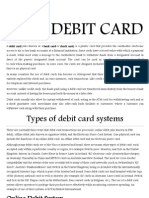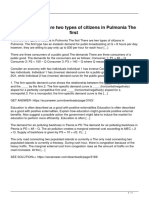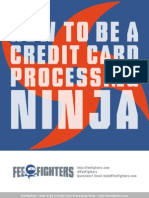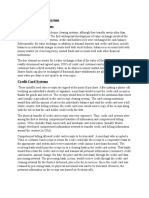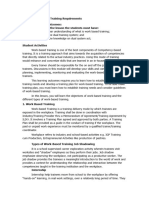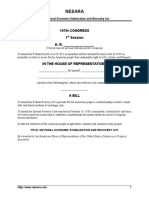Debit Card and Credit Card
Debit Card and Credit Card
Uploaded by
Neeraj DwivediCopyright:
Available Formats
Debit Card and Credit Card
Debit Card and Credit Card
Uploaded by
Neeraj DwivediCopyright
Available Formats
Share this document
Did you find this document useful?
Is this content inappropriate?
Copyright:
Available Formats
Debit Card and Credit Card
Debit Card and Credit Card
Uploaded by
Neeraj DwivediCopyright:
Available Formats
A maximum commission of 40 per cent of the first year’s premium
7.5 per cent of the second year’s premium and
5 per cent thereafter.
The commission paid is limited to 2 per cent in case of single premium policies.
Pension plans: Commission is limited to 7.5 per cent of the first year’s premium and 2 per cent
thereafter.
1.6 Credit Cards & Debit Cards
A card issued by a finance company giving the holder an option to purchase goods and services,
usually at point of sale. Banks charge interest on the amount whom by the card holder Thus chards
are primarily used for short-term financing. Interest usually begins one month after a purchase is
made and borrowing limits are pre-set according to the individual’s credit rating.
Credit cards have higher interest rates (around 34-36 % per year) than most consumer loans or lines
of credit. Almost every store accepts payment for goods and services through credit cards. Because
of their wide spread acceptance, credit cards are one of the most popular forms of payment for
consumer goods and services.
A credit card is a payment card issued to users as a system of payment. It allows the cardholder
to pay for goods and services based on the holder’s promise to pay for them. The issuer of the card
creates a revolving account and grants a line of credit to the consumer (or the user) from which the
user can borrow money for payment to a merchant or as a cash advance to the user.
A. Credit card
a. Credit card numbering:
The numbers found on credit cards have a certain amount of internal structure, and share a common
numbering scheme. The card number’s prefix, called the Bank Identification Number, is the sequence
of digits at the beginning of the number that determine the bank to which a credit card number
belongs.
Ancillary Services of Banks 37
First six digits for MasterCard and Visa cards
Next nine digits are the individual account number, and
Final digit is a validity check code.
In addition to the main credit card number, credit cards also carry issue and expiration dates (given
to the nearest month), as well as extra codes such as issue numbers and security codes. Not all
credit cards have the same sets of extra codes nor do they use the same number of digits.
b. Parties to Credit card:
Cardholder: The holder of the card used to make a purchase; the consumer.
Card-issuing bank: The financial institution or other organization that issued the credit
card to the cardholder. This bank bills the consumer for payment and bears the risk that
the card is used fraudulently. American Express and Discover were previously the only
card-issuing banks for their respective brands, but as of 2007, this is no longer the case.
Cards issued by banks to cardholders in a different country are known as offshore credit
cards.
Merchant: The individual or business accepting credit card payments for products or
services sold to the cardholder.
Acquiring bank: The financial institution accepting payment for the products or services
on behalf of the merchant.
Independent sales organization: Resellers (to merchants) of the services of the acquiring
bank.
Merchant account: This could refer to the acquiring bank or the independent sales
organization, but in general is the organization that the merchant deals with.
Credit Card association: An association of card-issuing banks such as Discover, Visa,
MasterCard, American express, etc. that set transaction terms for merchants, card-issuing
banks, and acquiring banks.
Transaction network: The system that implements the mechanics of the electronic
transactions. May be operated by an independent company, and one company may operate
multiple networks.
Insurance providers: Insurers underwriting various insurance protections offered as credit
card perks, for example, Car Rental Insurance, Purchase Security, Hotel Burglary Insurance,
Travel Medical Protection etc.
The flow of information and money between these parties — always through the card associations
— is known as the interchange, and it consists of a few steps.
c. Credit card Operations:
38 Banking Products & Operations - I
The Cardholder makes a purchase using a credit card. The merchant must obtain authorization
for the purchase from the bank who issued the card
The merchant swipes the credit card through a POS unit
The POS machine sends authorization request along with card data to Acquiring Processor, e.g.
First Data
The Acquiring Processor, First Data, routes the authorization request to Visa
Visa then forwards the authorization request to the Issuing Bank
The Issuing Bank verifies the authorization information then checks the account for available
funds or credit and sends an approval or decline to Visa.
Visa routes the approval / decline to the Acquiring Processor (F.D.).
The Acquiring Processor (F.D.) sends the approval or decline to the merchant’s terminal.
The merchant completes the sale with the customer.
If approved, the customer is billed for the transaction on his next monthly statement.
Batching: Authorized transactions are stored in “batches”, which are sent to the acquirer. Batches
are typically submitted once per day at the end of the business day. If a transaction is not submitted
in the batch, the authorization will stay valid for a period determined by the issuer, after which the
held amount will be returned to the cardholder’s available credit (see authorization hold). Some
transactions may be submitted in the batch without prior authorizations; these are either transactions
falling under the merchant’s floor limit or ones where the authorization was unsuccessful but the
merchant still attempts to force the transaction through. (Such may be the case when the cardholder
is not present but owes the merchant additional money, such as extending a hotel stay or car rental.)
Clearing and Settlement:
First Data submits request to Visa.
Visa in turn submits request to Issuing Bank.
Ancillary Services of Banks 39
Issuing Bank funds Visa.
Visa in turn funds First Data.
First Data settles funds with Merchant.
The acquirer sends the batch transactions through the credit card association, which debits the
issuers for payment and credits the acquirer. Essentially, the issuer pays the acquirer for the transaction.
Funding: Once the acquirer has been paid, the acquirer pays the merchant. The merchant receives
the amount totalling the funds in the batch minus the “discount rate”, “mid-qualified rate”, or “non-
qualified rate” which are tiers of fees the merchant pays the acquirer for processing the transactions.
Chargeback’s: A chargeback is an event in which money in a merchant account is held due to a
dispute relating to the transaction. Charge backs are typically initiated by the cardholder. In the event
of a chargeback, the issuer returns the transaction to the acquirer for resolution. The acquirer then
forwards the chargeback to the merchant, who must either accept the chargeback or contest it.
d. How is the Interest charges calculated by the credit card companies?
Credit card issuers usually waive interest charges if the balance is paid in full each month, but will
charge full interest on the entire outstanding balance from the date of each purchase if the total
balance is not paid.
For example, if a user had Rs 1,000 transaction and paid it in full within the grace period, there
would be no interest charge. If, however, even Rs1.00 of the total amount remained unpaid, interest
would be charged on the Rs 1,000 from the date of purchase until the payment is received. The
precise manner in which interest is charged is usually detailed in a cardholder agreement which may
be summarized on the back of the monthly statement. The general calculation formula which most
financial institutions use to determine the amount of interest to be charged is
Interest: APR/100 x ADB/365 x number of days revolved.
Take the annual percentage rate (APR) and divide by 100 then multiply by the amount of the
average daily balance (ADB) divided by 365 and then take this total and multiply by the total
number of days the amount revolved before payment was made on the account. Financial institutions
refer to interest charged back to the original time of the transaction and up to the time a payment
was made, if not in full, as residual retail finance charge (RRFC). Thus after an amount has revolved
and a payment has been made, the user of the card will still receive interest charges on their
statement after paying the next statement in full (in fact the statement may only have a charge for
interest that collected up until the date the full balance was paid, i.e. when the balance stopped
revolving).
e. Benefits to the credit card holders:
The main benefit of credit card to the card holder is convenience. Compared to debit cards and
cheques, a credit card allows small short-term loans to be quickly made to a customer who need
not calculate the balance which remains before every transaction, provided the total amounts does
do not exceed the maximum credit line for the card.
40 Banking Products & Operations - I
Many credit cards offer rewards and benefits packages, such as enhanced product warranties at no
cost, free loss/damage coverage on new purchases, various insurance protections, for example,
rental car insurance, common carrier accident protection, and travel medical insurance. Credit cards
can also offer reward points which may be redeemed for cash, products, or airline tickets.
f. Benefits to Merchants for accepting credit cards:
For merchants, a credit card transaction is often more secure than other forms of payment, such as
cheques, because the issuing bank commits to pay the merchant the moment the transaction is
authorized, regardless of whether the consumer defaults on the credit card payment (except for
legitimate disputes). In most cases, cards are even more secure than cash, because they discourage
theft by the merchant’s employees and reduce the amount of cash on the premises. Finally, credit
cards reduce the back office expense of processing checks/cash and transporting them to the bank.
For each purchase, the bank charges the merchant a commission (discount fee) for this service and
there may be a certain delay before the agreed payment is received by the merchant. The commission
is often a percentage of the transaction amount, plus a fixed fee (interchange rate).
g. Costs to the merchants for accepting credit cards:
Merchants are charged several fees for accepting credit cards. The merchant is usually charged a
commission of around 1 to 4 percent of the value of each transaction paid by credit card holder.
The merchant may also pay a variable charge, called an interchange rate, for each transaction.
Merchants are also required to lease processing terminals, for some terminals, merchants may also
need to subscribe to a separate telephone line.
Merchants must also satisfy data security compliance standards which are highly technical and
complicated. In many cases, there is a delay of several days before funds are deposited into a
merchant’s bank account. Because credit card fee structures are very complicated, smaller merchants
are at a disadvantage to analyze and predict fees.
Finally, merchants assume the risk of chargeback’s by consumers.
B. Debit Cards:
A debit card (also known as a bank card) is a plastic payment card that provides the cardholder
electronic access to his or her bank account(s) at a financial institution. Some cards have a stored
value with which a payment is made, while most relay a message to the cardholder’s bank to
withdraw funds from a payer’s designated bank account. The card, where accepted, can be used
instead of cash when making purchases.
Unlike credit cards, payments by using a debit card are immediately made from the cardholder’s
designated bank account. Debit cards usually also allow for instant withdrawal of cash, acting as the
ATM card for withdrawing cash. Merchants may also offer cash back facilities to customers, where
a customer can withdraw cash along with their purchase.
Ancillary Services of Banks 41
Details on the front of a typical debit card are:
Issuing bank logo
EMV chip
Hologram
42 Banking Products & Operations - I
Card number
Card brand logo
Expiration date
Cardholder’s name
Details on the reverse side of a typical debit card:
Magnetic stripe
Signature strip
Card Security Code
a. Debit Card system works:
Online debit cards require electronic authorization of every transaction and the debits are reflected
in the user’s account immediately. The transaction may be additionally secured with the personal
identification number (PIN) authentication system; some online cards require such authentication for
every transaction, essentially becoming enhanced automatic teller machine (ATM) cards.
Ancillary Services of Banks 43
One difficulty with using online debit cards is the necessity of an electronic authorization device at
the point of sale (POS) and sometimes also a separate PIN pad to enter the PIN, although this is
becoming commonplace for all card transactions in many countries.
Overall, the online debit card is generally viewed as superior to the offline debit card because of
its more secure authentication system and live status, which alleviates problems with processing lag
on transactions that may only issue online debit cards. Some on-line debit systems are using the
normal authentication processes of Internet banking to provide real-time on-line debit transactions.
b. Advantages of a Debit Card
Easy to obtain: Once you open an account most institutions will issue you a debit card upon
request.
Convenience: Purchases can be made by swiping the card rather than paying in cash.
Safety: You don’t have to carry cash or a cheque book.
Readily accepted: When out of town, debit cards are usually widely accepted
c. Disadvantages of a Debit Card
No grace period: Unlike a credit card, a debit card debits funds directly from your bank
account. A credit card allows you credit, thus leaving disposable cash in your account.
Check book balancing: Balancing your account may be difficult unless you record every debit
card transaction.
d. Difference between Credit and Debit Card:
Credit Card
Borrowing money from a bank or financial institution. (Spending “other’s” money)
Need not be connected to any bank account
Pay additional interest drawn on the amount borrowed
Limit: Credit line
Debit Card
Funds taken from the money that you have in your Bank account. (Spending your “own”
money)
Needs Checking Account / Savings Account
No interest to be paid
Limit: Equals your account balance / limit
44 Banking Products & Operations - I
You might also like
- Credit Card Management SystemDocument3 pagesCredit Card Management SystemPraful Gurav67% (3)
- Petition For Mutual Divorce Uis 13 (B) of HMA, 1955Document3 pagesPetition For Mutual Divorce Uis 13 (B) of HMA, 1955Neeraj Dwivedi78% (9)
- Credit Card AuthurizationDocument34 pagesCredit Card Authurizationkoms010100% (1)
- Random Credit Card Numbers Generator - NamsoGen PDFDocument2 pagesRandom Credit Card Numbers Generator - NamsoGen PDFteen starNo ratings yet
- Black Book PDFDocument62 pagesBlack Book PDFfaik100% (1)
- FLIPKART MayankDocument65 pagesFLIPKART MayankNeeraj DwivediNo ratings yet
- Debit CardDocument22 pagesDebit CardDivya GoelNo ratings yet
- Credit Card ProcessingDocument16 pagesCredit Card ProcessingSandeep YadavNo ratings yet
- Credit CardDocument100 pagesCredit CardSonia Dutt100% (1)
- Project On Credit CardDocument86 pagesProject On Credit CardWaxen Vency Dmello86% (7)
- Master CardDocument22 pagesMaster CardAsef KhademiNo ratings yet
- Application For Maintenance Uis 125, CRPCDocument3 pagesApplication For Maintenance Uis 125, CRPCNeeraj Dwivedi67% (3)
- Petition For Restitution For Conjugal Rights Uis 9, HMA, 1955Document5 pagesPetition For Restitution For Conjugal Rights Uis 9, HMA, 1955Neeraj DwivediNo ratings yet
- Activity Ratio Presentation CompleteDocument14 pagesActivity Ratio Presentation CompleteMohsin Raza100% (1)
- Basel NormsDocument23 pagesBasel NormsPranu PranuNo ratings yet
- Solved There Are Two Types of Citizens in Pulmonia The FirstDocument1 pageSolved There Are Two Types of Citizens in Pulmonia The FirstM Bilal SaleemNo ratings yet
- Credit CardDocument51 pagesCredit CardSmita JainNo ratings yet
- Evaluation of Some Online Banks, E-Wallets and Visa/Master Card IssuersFrom EverandEvaluation of Some Online Banks, E-Wallets and Visa/Master Card IssuersNo ratings yet
- All You Need to Know About Payday LoansFrom EverandAll You Need to Know About Payday LoansRating: 5 out of 5 stars5/5 (1)
- E Money and e Payment System 1 1Document114 pagesE Money and e Payment System 1 1Aman SinghNo ratings yet
- Consumer Credit CardsDocument32 pagesConsumer Credit CardsMuhammad Mazhar YounusNo ratings yet
- Credit Card Information 1Document3 pagesCredit Card Information 1api-3710686770% (1)
- Credit CardDocument81 pagesCredit Cardsuryakantshrotriya100% (1)
- 5 Different Kinds of Plastic MoneyDocument4 pages5 Different Kinds of Plastic MoneyChristina Jarvis100% (3)
- Credit Card ProcessingDocument28 pagesCredit Card ProcessingvluhadNo ratings yet
- Visa Classic 3. Rupay Classic 6. Mastercard Gold 8. Rupay Platinum 9. Rupay Select CardDocument4 pagesVisa Classic 3. Rupay Classic 6. Mastercard Gold 8. Rupay Platinum 9. Rupay Select CardVikramjeet SinghNo ratings yet
- WH Credit Card DataDocument39 pagesWH Credit Card DataFlaviub23No ratings yet
- Credit Card Market in IndiaDocument62 pagesCredit Card Market in IndiaDavid BarlaNo ratings yet
- Credit CardDocument77 pagesCredit CardSamuel DavisNo ratings yet
- Buy Now Pay Later BNPLOn Your Credit CardDocument26 pagesBuy Now Pay Later BNPLOn Your Credit CardShivaniNo ratings yet
- Credit Card Transaction Using Face Recognition AuthenticationDocument7 pagesCredit Card Transaction Using Face Recognition AuthenticationRanjan BangeraNo ratings yet
- Credit Card Numbers Shrink, But Spends Rise: Icici Bank HSBC Barclays Deutsche BankDocument15 pagesCredit Card Numbers Shrink, But Spends Rise: Icici Bank HSBC Barclays Deutsche BankJairam PerumalNo ratings yet
- Types of E-Payment SystemDocument5 pagesTypes of E-Payment SystemVaishali panjabiNo ratings yet
- Online Paymet SystemsDocument23 pagesOnline Paymet SystemsPrabhjeet Sumit GoklaneyNo ratings yet
- Black Book Payment BankDocument62 pagesBlack Book Payment BankVicky VishwakarmaNo ratings yet
- Credit CardsDocument50 pagesCredit Cardsprince100% (3)
- Client Account MaintenanceDocument18 pagesClient Account MaintenanceNirajanNo ratings yet
- Research MethodologyDocument34 pagesResearch MethodologySangeetaLakhesar80% (5)
- Verified by Visa & MasterCard SecureCode: Fraudulent Chargeback Liability ShiftDocument16 pagesVerified by Visa & MasterCard SecureCode: Fraudulent Chargeback Liability Shiftmskaler100% (1)
- Credit Card and Debit CardDocument28 pagesCredit Card and Debit CardSamson D'souzaNo ratings yet
- Debit Card & Credit Card & Their AdvantagesDocument24 pagesDebit Card & Credit Card & Their AdvantagesAkash Deep100% (1)
- Virtual Debit Card FAQDocument9 pagesVirtual Debit Card FAQKelly C. GilesNo ratings yet
- Plastic Money in IndiaDocument71 pagesPlastic Money in IndiaDexter LoboNo ratings yet
- Debit and Credit Card - EditedDocument24 pagesDebit and Credit Card - EditedNikita MutrejaNo ratings yet
- Credit Card Management Information SysteDocument9 pagesCredit Card Management Information SysteAnant JainNo ratings yet
- Payments Can Be Made Using Visa, Mastercard and Discover: Credit Card Payment FormDocument1 pagePayments Can Be Made Using Visa, Mastercard and Discover: Credit Card Payment FormLionel BoopathiNo ratings yet
- Document Checklist For MCB Visa Credit Card (Roshan Digital Accountholders)Document16 pagesDocument Checklist For MCB Visa Credit Card (Roshan Digital Accountholders)Abdul AhadNo ratings yet
- Credit CardDocument23 pagesCredit Carddeepak kumarNo ratings yet
- e BankingDocument61 pagese BankingRiSHI KeSH GawaINo ratings yet
- Debit Card - Project Wark PDFDocument158 pagesDebit Card - Project Wark PDFManisha GuptaNo ratings yet
- Online Payment SystemDocument30 pagesOnline Payment SystemDjks YobNo ratings yet
- Visa Credit Card BillDocument2 pagesVisa Credit Card BillLodjuaNo ratings yet
- Fixed DepositDocument119 pagesFixed Depositshreeya salunkeNo ratings yet
- HDFC Bank Credit Card ChargesDocument12 pagesHDFC Bank Credit Card ChargesKumar RockyNo ratings yet
- Plastic MoneyFullProjectDocument49 pagesPlastic MoneyFullProjectTanya Hughes100% (1)
- Credit Card Statement - AddressDocument2 pagesCredit Card Statement - AddressKiranNo ratings yet
- Cards: Debit Card Credit Card Prepaid CardDocument14 pagesCards: Debit Card Credit Card Prepaid CardJAHID HOSSAINNo ratings yet
- Credit Card Application Form - 9201701481146 PDFDocument11 pagesCredit Card Application Form - 9201701481146 PDFRajesh KumarNo ratings yet
- ICICI Bank Credit CardsDocument24 pagesICICI Bank Credit CardsRachana NagpalNo ratings yet
- American Express Credit CardsDocument2 pagesAmerican Express Credit CardsAlex DA CostaNo ratings yet
- Using CR CardsDocument2 pagesUsing CR CardsFlaviub23No ratings yet
- Citibank CreditCard 1284stmt 01072015 1437613957840Document6 pagesCitibank CreditCard 1284stmt 01072015 1437613957840JeffreyNo ratings yet
- Credit Card System NewDocument71 pagesCredit Card System Newشايك يوسفNo ratings yet
- Methods to Overcome the Financial and Money Transfer Blockade against Palestine and any Country Suffering from Financial BlockadeFrom EverandMethods to Overcome the Financial and Money Transfer Blockade against Palestine and any Country Suffering from Financial BlockadeNo ratings yet
- Calculation of EMI and Interest On Savings AccountDocument7 pagesCalculation of EMI and Interest On Savings AccountNeeraj DwivediNo ratings yet
- Arjun STRDocument54 pagesArjun STRNeeraj DwivediNo ratings yet
- Complaint For Dishonorned of Cheque Uis 138 NI ActDocument5 pagesComplaint For Dishonorned of Cheque Uis 138 NI ActNeeraj DwivediNo ratings yet
- Arjun STRDocument51 pagesArjun STRNeeraj Dwivedi100% (1)
- Mobile Banking and Internet BankingDocument10 pagesMobile Banking and Internet BankingNeeraj DwivediNo ratings yet
- Political Science 1Document21 pagesPolitical Science 1Neeraj DwivediNo ratings yet
- Apllication For Uncertified Copy From The CourtDocument2 pagesApllication For Uncertified Copy From The CourtNeeraj Dwivedi100% (1)
- Law of Contract 2Document73 pagesLaw of Contract 2Neeraj DwivediNo ratings yet
- Sociology of Contemporary IndiaDocument16 pagesSociology of Contemporary IndiaNeeraj Dwivedi100% (1)
- Petition For Divorce Uis 13 (I) (B) of HMA, 1955Document3 pagesPetition For Divorce Uis 13 (I) (B) of HMA, 1955Neeraj DwivediNo ratings yet
- Law of Tort and Consumer ProtectionDocument64 pagesLaw of Tort and Consumer ProtectionNeeraj DwivediNo ratings yet
- To Whomsoever It May Concern: Authorized SignatureDocument1 pageTo Whomsoever It May Concern: Authorized SignatureNeeraj DwivediNo ratings yet
- Chapter 2Document5 pagesChapter 2Neeraj DwivediNo ratings yet
- Birth Injuries To The BabyDocument7 pagesBirth Injuries To The BabyNeeraj DwivediNo ratings yet
- 2 ResumeDocument1 page2 ResumeNeeraj DwivediNo ratings yet
- Submitted in The Partial Fulfilment of Degree of Bachelor of Business Administration (2015-2018)Document8 pagesSubmitted in The Partial Fulfilment of Degree of Bachelor of Business Administration (2015-2018)Neeraj DwivediNo ratings yet
- Himanshu Yadav Hero MotorDocument57 pagesHimanshu Yadav Hero MotorNeeraj DwivediNo ratings yet
- Curriculum Vitae SanjayDocument2 pagesCurriculum Vitae SanjayNeeraj DwivediNo ratings yet
- Chapter 1 MPRDocument14 pagesChapter 1 MPRNeeraj DwivediNo ratings yet
- Neeraj Dwivedi: House No. 321, Block No. 06 Mayur ViharDocument1 pageNeeraj Dwivedi: House No. 321, Block No. 06 Mayur ViharNeeraj DwivediNo ratings yet
- Amazon Online Service: " Pvt. LTD."Document54 pagesAmazon Online Service: " Pvt. LTD."NEERAJ DWIVEDINo ratings yet
- TO Whomsoever It May Concern: Ltd. From 2 June, 2017 To 31 July, 2017Document1 pageTO Whomsoever It May Concern: Ltd. From 2 June, 2017 To 31 July, 2017Neeraj DwivediNo ratings yet
- Chapter-1 Introduction and Nature of Job AssignedDocument40 pagesChapter-1 Introduction and Nature of Job AssignedNeeraj DwivediNo ratings yet
- Caput SuccedaneumDocument2 pagesCaput SuccedaneumNeeraj DwivediNo ratings yet
- Moksh FlipkartDocument61 pagesMoksh FlipkartNeeraj DwivediNo ratings yet
- "Kotak Mahindra Bank LTD.": A Summer Trainig Report ONDocument71 pages"Kotak Mahindra Bank LTD.": A Summer Trainig Report ONNeeraj Dwivedi100% (1)
- FI CA ConfigurationDocument17 pagesFI CA ConfigurationAgnaldo GomesNo ratings yet
- VALUE CREATION by FIRMS. (Academy of Management Best Papers Proceedings, Vol. 1996, Issue 1) (1996)Document7 pagesVALUE CREATION by FIRMS. (Academy of Management Best Papers Proceedings, Vol. 1996, Issue 1) (1996)Lucas MoreiraNo ratings yet
- Module 1.3 Historical Background of GlobalizationDocument8 pagesModule 1.3 Historical Background of GlobalizationJade BoadoNo ratings yet
- Carbon Credit Market Scheme 2023Document3 pagesCarbon Credit Market Scheme 2023diksha chouhanNo ratings yet
- 2-DPR Format II CSR Proposal by External Agency FRM II Rev 02Document2 pages2-DPR Format II CSR Proposal by External Agency FRM II Rev 02ShivajiNo ratings yet
- Global / International Issues: Strategic Management: Concepts & Cases 13 Edition Fred DavidDocument25 pagesGlobal / International Issues: Strategic Management: Concepts & Cases 13 Edition Fred DavidSuciana Faskalina100% (1)
- Infosys Balance SheetDocument28 pagesInfosys Balance SheetMM_AKSINo ratings yet
- Caets: International Council of Academies of Engineering and Technological Sciences, IncDocument4 pagesCaets: International Council of Academies of Engineering and Technological Sciences, Incapi-228693180No ratings yet
- Business KPI'sDocument24 pagesBusiness KPI'sJonathan Morales100% (10)
- Answer All Questions in Part A. Answer Only Three Questions in Part BDocument9 pagesAnswer All Questions in Part A. Answer Only Three Questions in Part BHazim BadrinNo ratings yet
- Why Ghalib?: Skilled Sales & Marketing ProfessionalDocument1 pageWhy Ghalib?: Skilled Sales & Marketing ProfessionalBaXit FerozNo ratings yet
- Unit 4Document10 pagesUnit 4kaicaras16No ratings yet
- Plan de NegociosDocument3 pagesPlan de NegociosMaria Victoria Olarte LopezNo ratings yet
- Bikanerwala VasuDocument17 pagesBikanerwala VasuHEENA GARGNo ratings yet
- Investment BookDocument26 pagesInvestment BookBobyBrownNo ratings yet
- Nesara: 107th CONGRESS 1 Session H. R.Document74 pagesNesara: 107th CONGRESS 1 Session H. R.Jole BambaNo ratings yet
- Marketing Objectives of Coca Cola - Marketing Strategy of Coca ColaDocument14 pagesMarketing Objectives of Coca Cola - Marketing Strategy of Coca ColaZekria Noori Afghan100% (3)
- Cost Accounting: Job Order CostingDocument17 pagesCost Accounting: Job Order CostingElvira Ayu SosiliaNo ratings yet
- Autoss: Product Manufacturer Description Quantity SubtotalDocument1 pageAutoss: Product Manufacturer Description Quantity SubtotalKien Nguyen TrungNo ratings yet
- Update (Isi Di Form, Kalo Revisi Tinggal Isi Lagi)Document11 pagesUpdate (Isi Di Form, Kalo Revisi Tinggal Isi Lagi)Yudo RusyantoNo ratings yet
- Value Investing Congress NY 2010 AshtonDocument26 pagesValue Investing Congress NY 2010 Ashtonbrian4877No ratings yet
- Mock 1 Paper 2Document6 pagesMock 1 Paper 2L MyNo ratings yet
- Sample Paper 2: C) Self-Contained Units of OrganizationsDocument10 pagesSample Paper 2: C) Self-Contained Units of OrganizationsJatinder Pal SinghNo ratings yet
- f2cdfMODULE Menu EngineeringDocument3 pagesf2cdfMODULE Menu EngineeringUtkarsh HsraktuNo ratings yet
- MSG Luton Managing Small and Medium Sized Enterprises 10.2.21Document19 pagesMSG Luton Managing Small and Medium Sized Enterprises 10.2.21MarianAdragaiNo ratings yet
- I Want To Develop A Clear Plan: On How To Grow My Idea Into Something BiggerDocument3 pagesI Want To Develop A Clear Plan: On How To Grow My Idea Into Something BiggeradinaNo ratings yet
- 2nd PUC Economics Eng 2022Document68 pages2nd PUC Economics Eng 2022meet.ghetiya08No ratings yet







